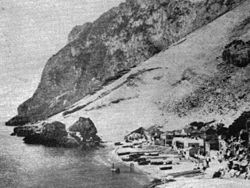Catalan Bay
| Catalan Bay | |
| Gibraltar | |
|---|---|
 Catalan Bay in the morning, looking North | |
| Location | |
| Location: | 36°8’20"N, 5°20’29"W |
| Data | |
| Local Government | |
| Council: | City of Gibraltar |
Catalan Bay is a small bay and fishing village in Gibraltar, on the eastern side of The Rock, which divides it from the main city. Catalan Bay is the only discrete village of Gibraltar not contiguous with the townscape which fills the western side of the territory.
Catalan Bay has long been inhabited by the descendants of Genoese fishermen. Its place as a fishing village has come to be overtaken by its service as a holiday resort.
Name
No one knows why Catalan Bay is so named, though there are a number of theories. One says that the bay is named after a group of around 350 settlers from Catalonia, military men believed to have settled here after having assisted the Anglo-Dutch forces who won the Capture of Gibraltar during the War of Spanish Succession on 4 August 1704. However, no evidence exists to prove that any Catalans settled in Catalan Bay and although this theory is regularly used as the supporting argument for the origin of the name, it is only a supposition that they ever did.[1]
The Spanish name La Caleta (meaning 'small bay or cove') considerably pre-dates that of Catalan Bay. The fishing villages of La Tunara (La Línea de la Concepción, Spain) and La Caleta are mentioned in a Royal Dispatch of the 6 March 1634 of being under the jurisdiction of the "Tercio del Mar de Marbella y Estepona" in the Kingdom of Granada.[2] Since it has been called La Caleta for much longer than it has ever been called Catalan Bay, the second theory suggests that "Catalan" could simply be an English mispronunciation of Caleta.[1]
History

Historically, Catalan Bay had been populated by Genoese fishermen who were part of a much larger settlement pattern along the eastern coast of The Rock during the 17th and 18th centuries. In the 18th century Genoese was so widely spoken in Gibraltar that government notices were also published in this language alongside English and Spanish. Genoese was spoken in La Caleta well into the 19th century, dying out in the early decades of the twentieth.
There has been some discussion that the British may have mixed up Catalans with Genoese but it is by no means clear why they would suffer such a confusion especially since there is other evidence which demonstrates that the British were perfectly aware that the residents of La Caleta were Genoese: the orders for the siege of 1727 refer to this bay as the Genoese Cove and the numerous 18th and 19th century census record large numbers of people born in Genoa, not in Catalonia.[1]
During the nineteenth century only fishermen were permitted to live in Catalan Bay. They were required to have a fishing permit granted to them by the Governor and only a limited number of permits were issued. The families who live in the village today are mainly descendants of these Genoese fishermen,[1] and are colloquially known as caleteños.
Present

The beach at Catalan Bay, is the second biggest sandy beach in Gibraltar. It is very popular with both Gibraltarians and tourists, and can often become overcrowded during the summer months.
Catalan Bay is home to the Caleta Palace Hotel, a number of restaurants (specialising in fresh seafood) and the Roman Catholic Church of Our Lady of Sorrows. The statue of Our Lady of Sorrows is carried to the beach each September when the Roman Catholic Bishop of Gibraltar blesses the sea in what has become the village's main religious festival.[3]
Beyond Catalan Bay to the south is the nearby beach of Sandy Bay, but the coast road now ends there, due to the closure of Dudley Ward Tunnel for safety reasons in 2002. To the north lies Eastern Beach, Gibraltar's largest and most popular sandy beach.
Further reading
- Catalan Bay - E.G. Archer, E.P. Vallejo & Tito Benady
References
- ↑ 1.0 1.1 1.2 1.3 Discovergibraltar.com - Catalan Bay
- ↑ Jose Carlos de Luna (1949). Historia de Gibraltar.
- ↑ The Melting Pot